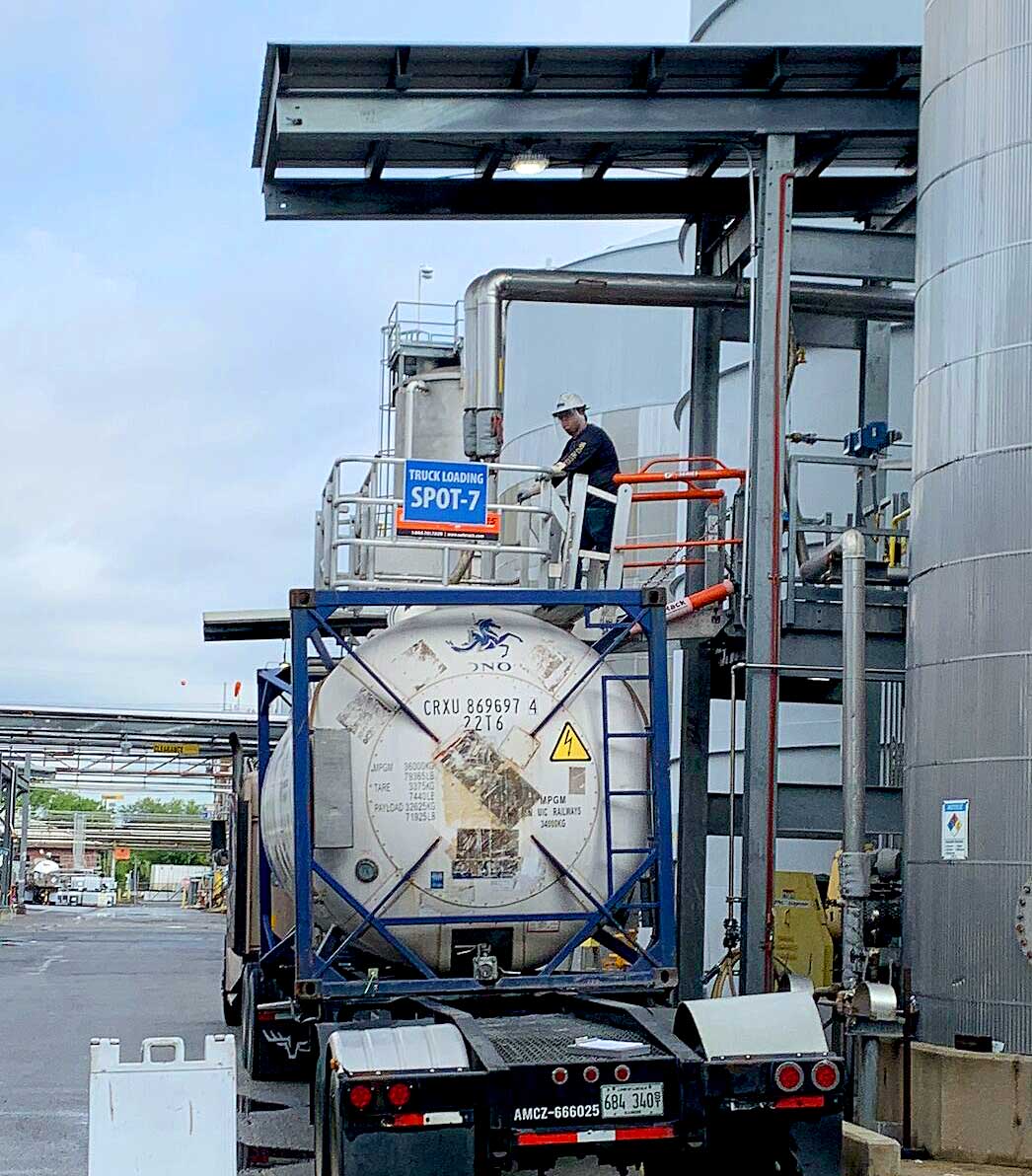ISOtainer Loading Rack, Gangway and Canopy Installation

While traveling on the road with a local account manager, Ray Evans, our chemical vertical market specialist made a courtesy call to a specialty chemical plant that manufactures engineered monomers and thermoplastics to follow up on a recent SafeRack installation.
The requirements for the project necessitated SafeRack designing a safe and efficient loading rack for both ISO containers and standard single hatch chemical trailers. Along with our platform/ half canopy and access gangway our design incorporated a modified 5’ x 6’ four rail safety cage with an articulating outboard handrail.
This style cage provides appropriate fall prevention for the operators while accessing hatches on top of the wider ISOs; and for non ISO-containers the cage width can be reduced to minimize outboard gaps when accessing smaller diameter road trailers.
ISOtainers, also known as intermodal tank containers, offer a safe and effective method of transporting pressurized hydrocarbons such as LPG, dimethyl ether, butane, and other renewables. Including cryogenic products such as LNG—where marine or barge tankers are not viable. Specifically designed to meet the requirements of ISO 6346: Intermodal Freight Containers, ISOtainers are constructed of high-strength corrosion-resistant steel. They are available in various sizes and capacities and can be equipped with various fittings and accessories to meet the specific needs of the cargo. ISOtainers offer several advantages over conventional tank containers, including increased safety, flexibility, and efficiency. Unlike other types of containers, iso tanks are constructed with a seal that prevents leaks and spillage. As a result, they can transport up to 60-70% more liquid cargo than drums or flexibags. In addition, iso tanks are reusable and have a high resale value. As a result, they are an ideal choice for transporting large volumes of liquid cargo.
These containers have a utility hole on the top, at least one valve, and another on the bottom. Shaped like a cylinder, iso tank containers often transport hazardous and non-hazardous liquids by ship, rail, or road. The outer shell of the iso tank containers is weather-resistant, and the frame is very sturdy. The inner surfaces of the iso tank containers have a smooth finish so that the commodities transported will not get stuck to the sides or bottom of the container. Some examples of liquids transported in iso tank containers include fruit juices, vegetable oils, pharmaceuticals, detergents, and chemicals. There are several different types of ISO tanks; each are designed to meet the specific loading requirements of the products being transported:
|
Container type |
Ideal usage |
|
Rubber-lined ISOtainer |
Acid-based chemicals |
|
T1 ISOtainer |
Wine and light liquids |
|
T11 ISOtainer |
Non-hazardous chemicals |
|
T14 ISOtainer |
With polyurethane and wool insulation used to transport hazardous chemicals and acids like HCI and zinc chloride |
|
T4 ISOtainer |
Steel construction and used to transport non-hazardous edible and non-edible oils |
|
T50 ISOtainer |
Gasses such as LPG and ammonia |
|
T75 ISOtainer |
Cryogenic gasses |
|
Food-grade Type |
Only loaded with food grade products |
|
Reefer Type |
Ideal for food and chemicals |
|
Gas Type |
Suitable for the transport of gaseous substances |
|
Silo Type |
Suitable for transport of grains and powders |
|
SWAP body tank |
Made of stainless steel and has more capacity than the usual 20-foot container tanks |
|
SWAP tank container |
Stainless steel construction with wool insulation, made for cargoes above 26,000 to 35,000 metric tons |
Loading and unloading operations with isotainers can be dangerous for workers if the proper safety precautions are not taken. Loading arms and gangways are often used in these operations, and worker safety should always be a priority. The unloading process is the receiver’s responsibility, and the driver should stay near his equipment in case of an incident. There are many potential hazards associated with loading and unloading operations, but following some simple safety guidelines can help to prevent accidents and injuries.
ISO tanks must undergo regular inspections to ensure they are safe for use. Some tanks feature baffles to prevent the movement of liquids during transit, while others are equipped with pressure relief valves to protect against overpressure. In addition, all ISO tanks must be equipped with an emergency shut-off valve to prevent the release of dangerous materials in the event of an accident. By undergoing regular inspections, ISO tanks can ensure the safety of the hazardous materials they transport.
Operators must be aware of fall hazards while working on top of iso tanks. There are a few ways to eliminate the risk of falling, such as using a loading safety cage or gangway. Handrails and safety gates can also offer fall protection when gaps exist between the sides of the iso tank and the loading area. To create and implement a safe loading and unloading environment for operators at your facility, you’ll need to consider all potential fall hazards. By doing so, you can keep your workers safe and prevent accidents from happening.



